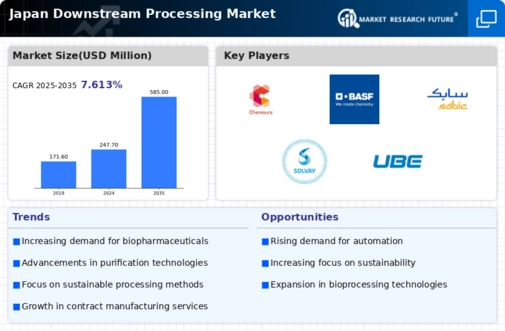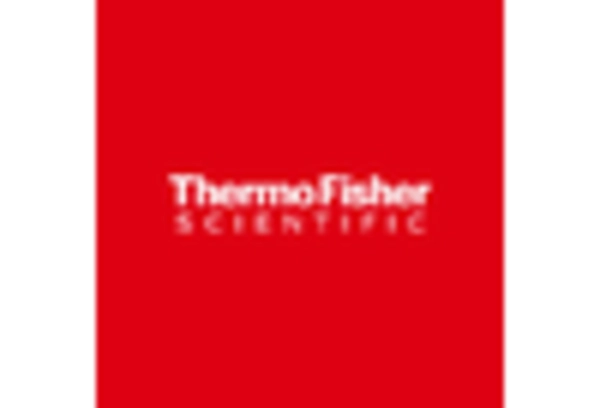Rising Demand for Biopharmaceuticals
The increasing demand for biopharmaceuticals in Japan is a key driver for the downstream processing market. As the healthcare sector evolves, the need for effective and efficient biopharmaceutical production processes becomes paramount. In 2025, the biopharmaceutical market in Japan is projected to reach approximately $20 billion, indicating a robust growth trajectory. This surge necessitates advanced downstream processing techniques to ensure high purity and yield of therapeutic proteins. Consequently, companies are investing in innovative technologies to enhance their downstream processing capabilities, thereby driving market growth. The downstream processing market is likely to benefit from this trend as manufacturers seek to optimize their production processes to meet the rising demand for biopharmaceuticals.
Technological Integration in Manufacturing
The integration of advanced technologies in manufacturing processes is transforming the downstream processing market in Japan. Automation, artificial intelligence, and data analytics are increasingly being adopted to streamline operations and improve efficiency. In 2025, it is anticipated that around 60% of downstream processing market players will implement automated systems to enhance productivity. This technological shift allows for real-time monitoring and optimization of production processes, leading to reduced operational costs and improved product quality. As manufacturers embrace these innovations, the downstream processing market is likely to experience significant growth, driven by the need for more efficient and cost-effective production methods.
Regulatory Compliance and Quality Standards
Stringent regulatory requirements in Japan significantly influence the downstream processing market. The pharmaceutical and biopharmaceutical sectors are subject to rigorous quality standards set by authorities such as the Pharmaceuticals and Medical Devices Agency (PMDA). Compliance with these regulations is essential for market players to ensure product safety and efficacy. In 2025, it is estimated that around 70% of companies in the downstream processing market will invest in technologies that facilitate compliance with these regulations. This focus on quality assurance not only enhances the credibility of products but also drives innovation in processing techniques. As a result, the downstream processing market is expected to expand as companies prioritize adherence to regulatory standards.
Growing Investment in Research and Development
Investment in research and development (R&D) is a crucial driver for the downstream processing market in Japan. As companies strive to innovate and develop new biopharmaceutical products, R&D expenditures are expected to rise significantly. In 2025, it is projected that R&D spending in the biopharmaceutical sector will exceed $5 billion, reflecting a commitment to advancing downstream processing technologies. This investment not only fosters innovation but also enhances the capabilities of the downstream processing market to meet evolving market demands. By focusing on R&D, companies can develop more efficient processing methods, thereby improving yield and reducing costs, which is essential for maintaining competitiveness in the market.
Increased Focus on Environmental Sustainability
The growing emphasis on environmental sustainability is reshaping the downstream processing market in Japan. Companies are increasingly adopting eco-friendly practices and technologies to minimize their environmental impact. In 2025, it is estimated that around 50% of players in the downstream processing market will implement sustainable practices in their operations. This shift is driven by both regulatory pressures and consumer demand for greener products. By investing in sustainable downstream processing methods, companies can not only enhance their market position but also contribute to broader environmental goals. This focus on sustainability is likely to propel the downstream processing market forward as businesses seek to align with global sustainability trends.

















Leave a Comment